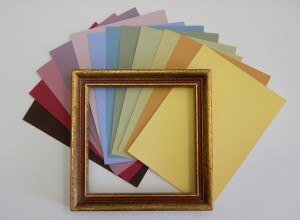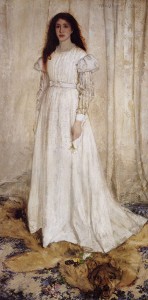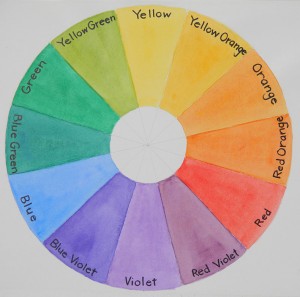 Knowledge of the color wheel and of color terms enable you to create the painting that you envision. Picking the colors that you think you will need, without significant planning, will bring frustration. So let’s start with some terms so we are both using the same definitions.
Knowledge of the color wheel and of color terms enable you to create the painting that you envision. Picking the colors that you think you will need, without significant planning, will bring frustration. So let’s start with some terms so we are both using the same definitions.
1.Color hue is the name of the color.
2.Saturation refers to the purity and concentration of the color.
3.Intensity describes the lack of white or black, the brightness of a color.
4.A shade is a color plus various amounts of added black. A tint is a color plus added white.
5.Pigment is the material used to add color to the medium the artist is using.
6.The spectrum is the divided band or array of colors seen when light passes through a prism (as when sunlight passes through water droplets and creates a rainbow).
We perceive color in pigment, because a pigment will absorb some light waves and reflect only the light waves that we identify as being that color. Yellow reflects only the waves we identify as yellow, while it absorbs the blue and violet rays. This is subtractive color. When red, blue, and yellow paint are mixed, the color becomes a muddy black. The colored waves are all absorbed. Refracted light or rainbow colors separated by a prism are additive color. When red, blue, and yellow lights are blended on one spot, the light becomes white.
Sir Isaac Newton (1642-1727) discovered this characteristic of colored light. He also established that a prism cannot divide pigment colors. He organized the spectrum into the first color wheel with the intense, saturated hues on the outside of the wheel. He then gradually shaded each color until it was grayed at the center of the wheel.
The Color Wheel
We are all familiar with the color wheel, so this diagram will be used as a reference. (I used watercolor and worked with Cobalt Blue, Cadmium Yellow, Cadmium Red, and Winsor Violet.)
Color groups have been assigned names.
7. Primary colors are the three basic colors–red, blue and yellow–from which all other colors are mixed.
8. The secondary colors are three mixtures of the primary colors–violet (red + blue), orange (red + yellow), and green (blue + yellow).
9. Tertiary colors are mixtures with a secondary color, such as yellow orange and red orange.
Color combinations have also been given names.
10. Complementary colors are any pair of colors that are exactly opposite each other on the color wheel, as is blue and orange or blue violet and yellow orange. When placed next to each other, they vye for your attention and seem to vibrate. Therefore they create an energy in a painting and immediately draw your attention.
11. A split complementary combo uses a color and the tertiary color on each side of the opposite complementary color (violet and yellow green and yellow orange), softening the vibrancy of the combination.
12. A triad uses any three colors that are equally apart from each other on the wheel creating different moods or emotional responses depending on which triad is selected. A tetrad uses four colors equally spaced.
13. Analogous colors are adjacent to each other or neighboring colors ( blue violet, violet, and red violet), creating a pleasant harmony. The middle complement can be added to create an accent or point of interest (yellow).
14. A monochromatic scheme uses shades and tints of one color.
This monochromatic painting is James Mc Neill Whistler’s Symphony in White, No. 1: The White Girl (1862). It is found on www.public-domain-photos.org/page/3.
As you become familiar with these combinations, you will find them in natural and designed harmonies everywhere. Play with these combinations to see what season they represent, what time of day they portray, or what mood they evoke. My next blog post will discuss the use of value and temperature of color.
An exceptional book to use in studying color is Nita Leland’s Exploring Color. It is all encompassing, filled with examples and exercises.



